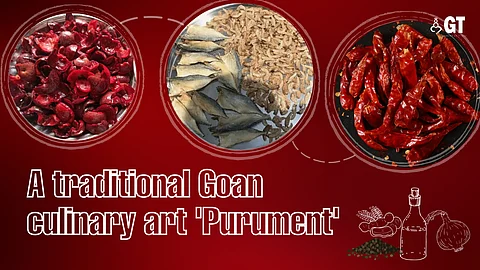

BY ASAVARI KULKARNI
Midsummer in Goa is seeing record-breaking temperatures, the highest seen in the last 50 years. Cities are abuzz with festivals and entertainment despite the scorching summer heat. Tourists are flooding the coastline, and the working Goan population is off to hill stations to beat the heat.
Away from the hustle and bustle of the city, in the villages of Goa, we encounter preparations for the monsoon season.
The blooming of the bahawa (Cassia fistula) and the gulmohar (Delonix regia) and the bursting open of the cotton pods of the sawar (Bombax ceiba) are harbingers of the arrival of the pre-monsoon time. This is when people become busy reroofing (ghar shivap), a ritual must for houses with clay tiles.
Women are busily involved in the most important task of the summer, making purument. The word is derived from the Portuguese “proviso” meaning “provisions”. The method of storing provisions required for the monsoon is commonly called purument. In some places, it is called valvan or begmi.
Storing food for a season (winter/monsoon) when less is available, is an age-old practice all over the world. The drying of food, especially of meat and fish is seen even in the prehistoric period.
Evidence shows that different cultures actively dried foods in the hot sun. Food items are preserved using the simple principle of removing moisture from them using solar energy.
Since drying reduces the moisture in the food, making them lightweight and convenient to store, it is the most widely used method of preparing food for storage.
There are other methods of preserving foods like freezing and canning. However, dried foods are a good source of quick energy and wholesome nutrition since the only thing lost during preservation is moisture. This method is used all over India in different cultures. The regional foods, fruits and vegetables are dried and preserved for future use.
Goa is a part of the Western Ghats, a region of India that receives copious amounts of rainfall. Though over the years the intensity of rainfall has either reduced or has become sporadic, a few decades back it was a season of a natural lockdown.
Due to heavy downpours, one could hardly move out of the house. Buying food was a difficult task. The sun would go on a holiday for days together. At this time, preserved food was the only option available.
Fishing was banned during the monsoons in 1981. However, even before that fishing in the rainy season was a tedious job. Therefore, all those items required to make food were preserved during the summertime. May it be sun-drying the essential food items like cereals, pulses, spices, salt and fish, or collecting firewood required throughout the monsoon season, all were an integral part of the purument.
Local items like tefela, halsande, otam sola (Artocarpus lacucha), mango seeds and different varieties of chillies were a must for purument. There were special preparations like fryums of rice, wheat, sago, etc; papad of jackfruit, breadfruit, black grams, potato; spice-stuffed chilies; vadyo or fryums of ash gourd (kuvanlo); sweet fruit rolls of jackfruit and mango; jams and pickles of mango, amla, lemon, karanda, jackfruit, bimbli (bilimbi), karmal (star fruit), etc.
Besides this, making special pickles of prawns and mackerels, special garam masala and preserving raw mango, jackfruits and hog plums in salt was part of the purument routine.
Pounding tamarind into small balls,preparing solam from bhindda (kokum), making syrup from kokum, butter from kokum seeds, etc was a tedious job, but women used to do it with dedication.
Goa is a land of fish eaters. A true Goan (of course, the non-vegetarian) would not survive without fish. So, during the monsoon, dried fish varieties like mackerel, prawns, etc. would compensate for the non-availability of fresh fish. This was like a boon for those people who had moved to other countries or states to earn their bread and butter and where fish was not available.
The methods used for drying these food items are unique to Goa. A few decades back, when plastic was not an integral part of our lives, we used natural materials to preserve food. For example, jackfruit rolls would be dried on the leaf of kumyo, jackfruit papad on the banana leaf, and fryums on the nonedible arum leaf.
Special glass bottles and porcelain jars were thoroughly washed and sundried to store the food items. Newly harvested rice, after being boiled, was preserved in a special container called mudi made from paddy straw.
Salt was preserved in a container made from bhille mad stem (fishtail palm) called don or barkal, a barrel made of cane, lined with kumyo or palas (flame of the forest) leaves. Cereals and pulses were stored in cleaned and dried tin or aluminium containers.
In those days, natural preservatives like tefela (Zanthoxylum rhetsa), curry leaves and neem leaves were used as disinfectants. Wheat and chillies were dried with an application of oil to avoid any pests. Jackfruit seeds were preserved using anthill soil.
All these methods were eco-friendly and harmless to human health. Summer months would keep ladies busy with all this work. However, city folks could not access all these items in their backyard, hence they would buy them from the market.
Today, with the advancement of technology, all these items are available year-round. However, people, who enjoyed this bounty in their childhood, still prefer to buy these items in the market.
Purumet is not only merely the preservation of food, it is a reflection of the rich food diversity of Goa. At the pace we are destroying our forests, courtyards decked with the colourful canvas of purumet items may well be spoken of in the past tense.